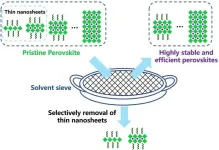(Press-News.org) ITHACA, N.Y. -- Cornell food scientists show that a standard quality test used for raw, organic milk is insufficient for distinguishing between specific groups of bacteria, suggesting that the criteria for determining milk quality at processing plants needs to be updated.
Their work was published Jan. 20 in the Journal of Dairy Science.
“Testing milk should not be one size fits all,” as tests should be used appropriately to give the best feedback to dairy producers, said lead author Renee Lee ’21, a master’s student who works in the laboratory of Martin Wiedmann, Ph.D. ’97, the Gellert Family Professor in Food Safety in the College of Agriculture and Life Sciences (CALS).
If the current test causes milk to be downgraded or rejected by processors, the farmers will earn less money or not get paid at all.
The present test, called the Laboratory Pasteurization Count (LPC), looks for thermoduric bacteria (strong enough to endure pasteurization) and does not differentiate whether bacteria form spores or not – a key factor in determining both the quality of milk and how producers need to address milk-production hygiene.
The latest scientific literature on this test is more than two decades old.
“You have to know what’s in the milk before you can troubleshoot it and develop the right corrective action,” Lee said. “There are different ways to address it.”
Some types of thermoduric bacteria that form spores are ever-present in the farm environment, found in bedding, feed and the air, Lee said. These types of bacteria can cause dairy products like milk and cheese to spoil, which contributes to food waste.
Non-sporeforming thermoduric bacteria can be found in improperly cleaned milking equipment and can be addressed by producers with improved maintenance and sanitation. Distinguishing between these two groups of thermoduric bacteria is important to reducing the time organic farmers spend troubleshooting elevated LPC results.
When dairies deliver organic milk to processors, the milk is sometimes tested for thermoduric bacteria using LPC. Under current standards, if thermoduric bacterial counts are high, the milk can be downgraded or even rejected by the processor.
In the paper, the researchers said that despite the test being used as a proxy for levels of bacterial spores in raw milk, there is limited knowledge of the types of organisms identified by this test in raw milk.
Organic milk is an important economic component for the dairy industry. New York state, for example, has more than 650 certified organic milk producers (as of June 2023) with more than half certified by Northeast Organic Farming Association of New York.
“We’re giving organic farmers the knowledge they need to make high-quality raw milk and for it to be economically viable,” said senior author Nicole H. Martin ’06, M.S. ’11, Ph.D. ’18, assistant research professor in dairy foods microbiology and the associate director of the Milk Quality Improvement Program in the Department of Food Science (CALS). “It will make a better dairy product in the end.”
In addition to Lee, Wiedmann and Martin, co-authors of “Troubleshooting High Laboratory Pasteurization Counts in Organic Raw Milk Requires Characterization of Dominant Thermoduric Bacteria, Which Includes Non-Sporeformers As Well As Sporeformers” are: researcher Rachel L. Evanowski ’13, M.S. ’19; Halle E. Greenbaum, graduate student, the University of Georgia; and Deborah Pawloski of the Quality Milk Production Services, Animal Health Diagnostic Center, College of Veterinary Medicine.
The research was funded by U.S. Department of Agriculture’s Organic Research and Extension Initiative.
-30-
END
Bacterial test for raw, organic milk may require more precision
2024-02-05
ELSE PRESS RELEASES FROM THIS DATE:
Brazilian researcher helps describe a novel species of jellyfish discovered in a remote location in Japan
2024-02-05
A gelatinous animal with a diameter of about 10 cm and a red stomach resembling the Cross of St George when seen from above. This is Santjordia pagesi, a newly described species of medusa. Medusae are a type of free-swimming, umbrella-shaped jellyfish with a reduced stalk.
The new species is described in an article published in the journal Zootaxa. The study was conducted by an international group of researchers that included a Brazilian scientist supported by FAPESP.
The scientist in question is André Morandini, last author ...
Small but mighty – study highlights the abundance and importance of the ocean’s tiniest inhabitants
2024-02-05
Tiny plankton – measuring less than 20µm (or 0.02mm) in diameter – make up the majority of plankton in the ocean and play a critical role in the planet’s health, according to new research.
However, scientists say challenges in identifying them have led to them becoming a silent majority that is currently being overlooked when it comes to global ocean policy.
The study is one of the first to explore the abundance and importance of these tiny ocean inhabitants around the UK coastline, with the technology capable of monitoring them only having been introduced in around 2010.
However, ...
Bullied teens’ brains show chemical change associated with psychosis
2024-02-05
Researchers have found that adolescents being bullied by their peers are at greater risk of the early stages of psychotic episodes and in turn experience lower levels of a key neurotransmitter in a part of the brain involved in regulating emotions. The finding suggests that this neurotransmitter — a chemical messenger that transmits nerve impulses for communication by a nerve cell — may be a potential target for pharmaceutical interventions aimed at reducing the risk of psychotic disorders.
Psychosis is a mental state characterized by loss of contact with reality, incoherent speech and behavior, and typically hallucinations and delusions seen in psychiatric disorders ...
Unlocking precision medicine for inflammatory bowel disease
2024-02-05
The prevalence of inflammatory bowel disease (IBD), encompassing ulcerative colitis (UC) and Crohn's disease (CD), is rapidly increasing worldwide, affecting an estimated 6.8 million people. This surge brings significant economic burdens, with annual healthcare costs exceeding $12,000 and $7,000 for CD and UC patients, respectively. Tailored drug selection based on individual factors can potentially reduce these costs and improve patient outcomes.
Factors associated with a Western lifestyle such as urbanization, high animal protein intake, ultra-processed foods, and reduced fiber ...
High production of polyols using crude glycerol by wild-type safe yeasts
2024-02-05
Utilizing crude glycerol for the synthesis of high-value products offers a promising solution to counter the adverse effects of declining glycerol prices in the biodiesel sector. The prevalence of crude glycerol, a by-product of biodiesel production, across agriculture, biofuel, and industrial sectors is steadily rising. Recent advancements have demonstrated the effectiveness of both wild-type and mutant yeast strains as microbial cell factories capable of converting glycerol into a diverse array of valuable compounds, including microbial oils, sugar-alcohols (polyols), and organic acids. With the projected increase in biodiesel production, there is a need to explore integrated ...
Solvent sieve method sets new record for perovskite light-emitting diodes
2024-02-05
Using a simple solvent sieve method, researchers from the Ningbo Institute of Materials Technology and Engineering (NIMTE) of the Chinese Academy of Sciences (CAS) have taken the lead in developing highly efficient and stable perovskite light-emitting diodes (PeLEDs) with record performance.
The study was published in Nature Photonics.
Perovskites are one of the most promising optoelectronic materials due to their excellent optoelectronic performance and low preparation cost. Compared with traditional organic light-emitting diodes (OLEDs), PeLEDs have a narrower light-emitting spectrum and superior color ...
Combination therapy lowers blood pressure in patients receiving ibrutinib
2024-02-05
(WASHINGTON, Feb. 5, 2024) – Combination treatments with two or more blood pressure drugs can significantly reduce blood pressure in patients taking ibrutinib, according to a new study published in Blood Advances.
Targeted drugs such as ibrutinib have improved outcomes for patients with cancers of the lymphatic system, but patients treated with ibrutinib and other drugs in its class often develop new or worsening high blood pressure (or hypertension or HTN). Few studies have examined how best to treat this potentially serious side effect, nor do any formal guidelines exist to steer doctors toward the most effective treatments.
“To ...
Ultra-sensitive lead detector could significantly improve water quality monitoring
2024-02-05
Engineers at the University of California San Diego have developed an ultra-sensitive sensor made with graphene that can detect extraordinarily low concentrations of lead ions in water. The device achieves a record limit of detection of lead down to the femtomolar range, which is one million times more sensitive than previous sensing technologies.
“With the extremely high sensitivity of our device, we ultimately hope to detect even the presence of one lead ion in a reasonable volume of water,” said Prabhakar Bandaru, a professor in the Department of Mechanical and Aerospace Engineering at the UC San Diego Jacobs School of Engineering. “Lead exposure is a serious health concern, ...
World’s largest childhood trauma study uncovers brain rewiring
2024-02-05
The world’s largest brain study of childhood trauma has revealed how it affects development and rewires vital pathways.
The University of Essex study – led by the Department of Psychology’s Dr Megan Klabunde – uncovered a disruption in neural networks involved in self-focus and problem-solving.
This means under-18s who experienced abuse will likely struggle with emotions, empathy and understanding their bodies.
Difficulties in school caused by memory, hard mental tasks and decision making may also emerge.
Dr ...
Number of shark bites consistent with recent trends, with small spike in fatalities
2024-02-05
There was an increase in the number of unprovoked shark attacks worldwide and an uptick in fatalities in 2023 compared to the previous year. The University of Florida’s International Shark Attack File (ISAF), a scientific database of global shark attacks, confirmed 69 unprovoked bites in 2023. Although this is higher than the most recent five-year average of 63 attacks, the data remain consistent with long-term trends.
Ten of the past year’s unprovoked attacks were fatal, up from five the year before, with a disproportionate number occurring in Australia. Although the country accounted for 22% of all attacks, ...





